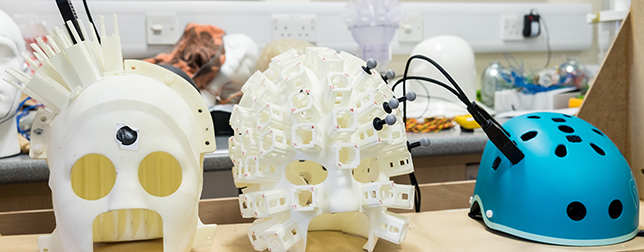Recording activities of neurons in your brain is a difficult process. The best tool for snooping on neurons in real time is Magnetoencephalography (MEG). However, it has a big drawback; participants must keep their heads totally still inside a huge scanner. This makes the method a no-go for young children, and it forbids studying the brain while people are on the move. Now, researchers in the UK have developed a wearable portable scanner that solves all those problems – a mask that looks like it came out of a horror film, transmits brain signals even when the person is moving.
The device, described in the journal Nature, could enable scientists to study brain activity in ways that aren’t possible with stationary brain scanners, like that of MRI or fMRI.
Read more USA Cycling Tackles Neuroscience by Partnering with Halo
Lead researcher Matt Brookes, a physicist at Nottingham University told BBC News:
“In terms of mapping brain activity, this represents a step change.”
“Neuroscientists will be able to envisage a whole new world of experiments where we try to work out what the brain is doing but whilst a person is behaving naturally and moving around.”
In the new study, researchers at the University of Nottingham and University College London, in the U.K., shrunk MEG to the size of helmet. The wearable brain scanner would enable researchers to record brain activity of people who find it difficult to remain still, such as babies, children, and people with movement disorders.
This new system would also allow researchers to conduct entirely new types of studies.

“You can look at aspects of brain function involving spatial navigation, which is hard to do with a subject who is stationary,” says co-author of the study Richard Bowtell, a professor of physics at the University of Nottingham. “You can also look at more natural interactions between people when they are free to move.”
Read more Kessler Foundation and Virtualwear Team Up to Improve Recovery Outcomes in Stroke Patients
The system is custom made for each individual user, with a 3D printed head cast that fits snugly over the scalp and face.
To make the scanner portable, Bowtell and his team replaced traditional sensors, which have a heavy, bulky cooling system, with tiny sensors that detect brain’s magnetic field in a different way. They used miniaturized quantum sensors dubbed pumped magnetometers (OPMs). These sensors can be attached directly to the scalp. They lock in place to sense the magnetic fields of the brain. The whole system weighs less than 1 kg.
The wearer, however can’t move around entirely freely – the scanner still needs to be worn inside a specially constructed room that counteracts the effect of the Earth’s natural magnetic field. There are also lots of other applications, according to Bowtell. The device could be used to allow more natural interactions between people by having two people each wear the helmet and speak face-to-face, he said.












